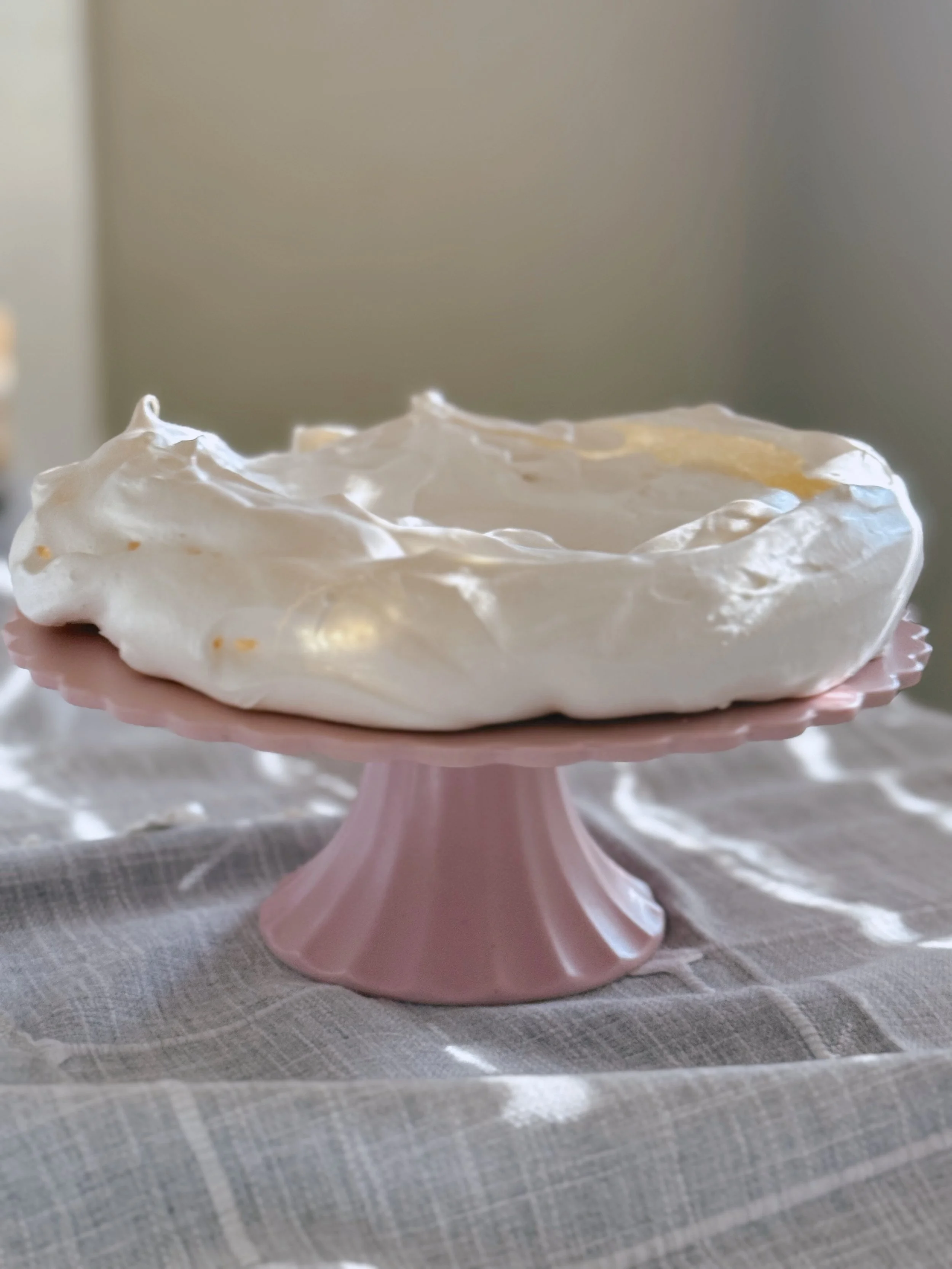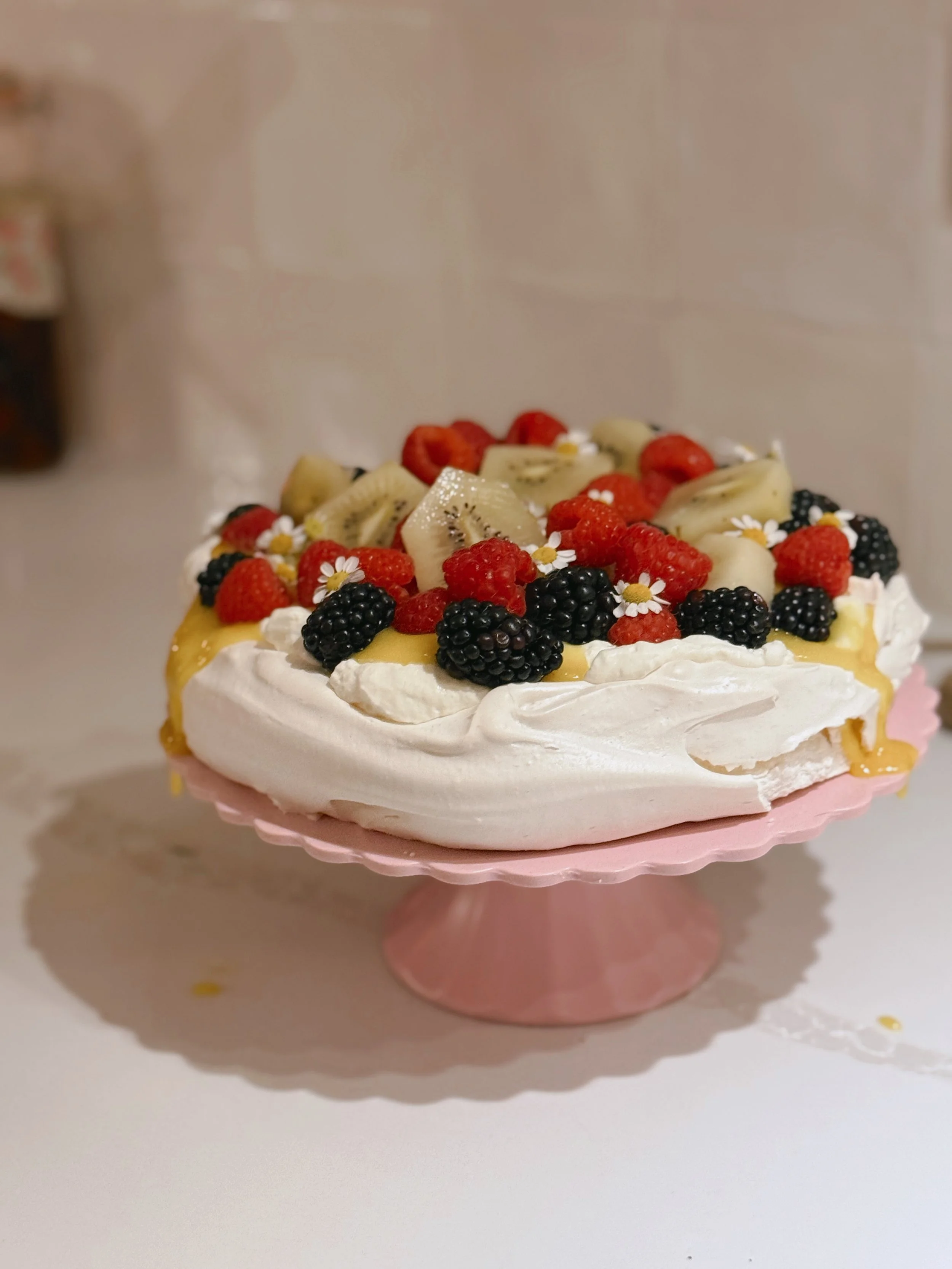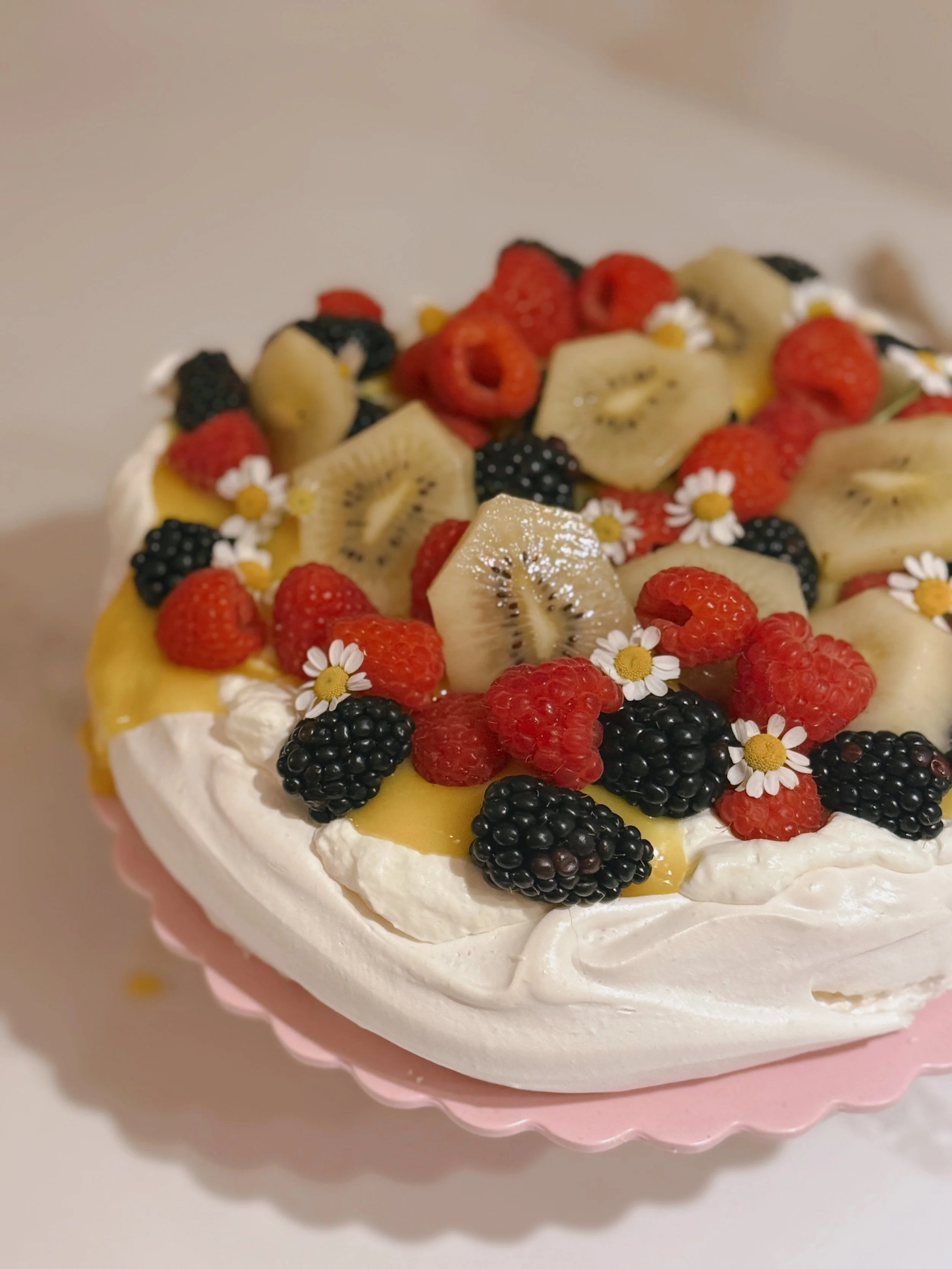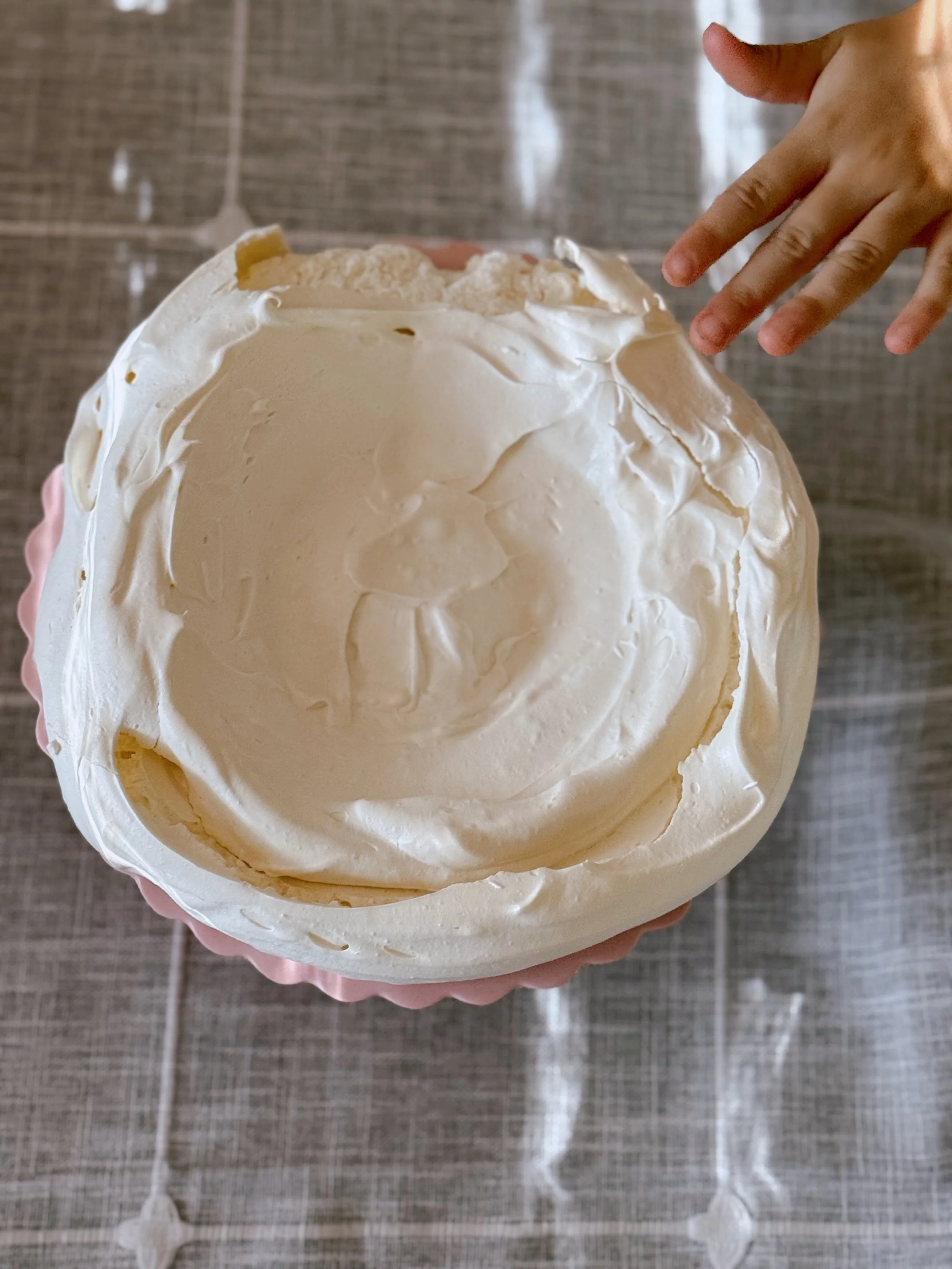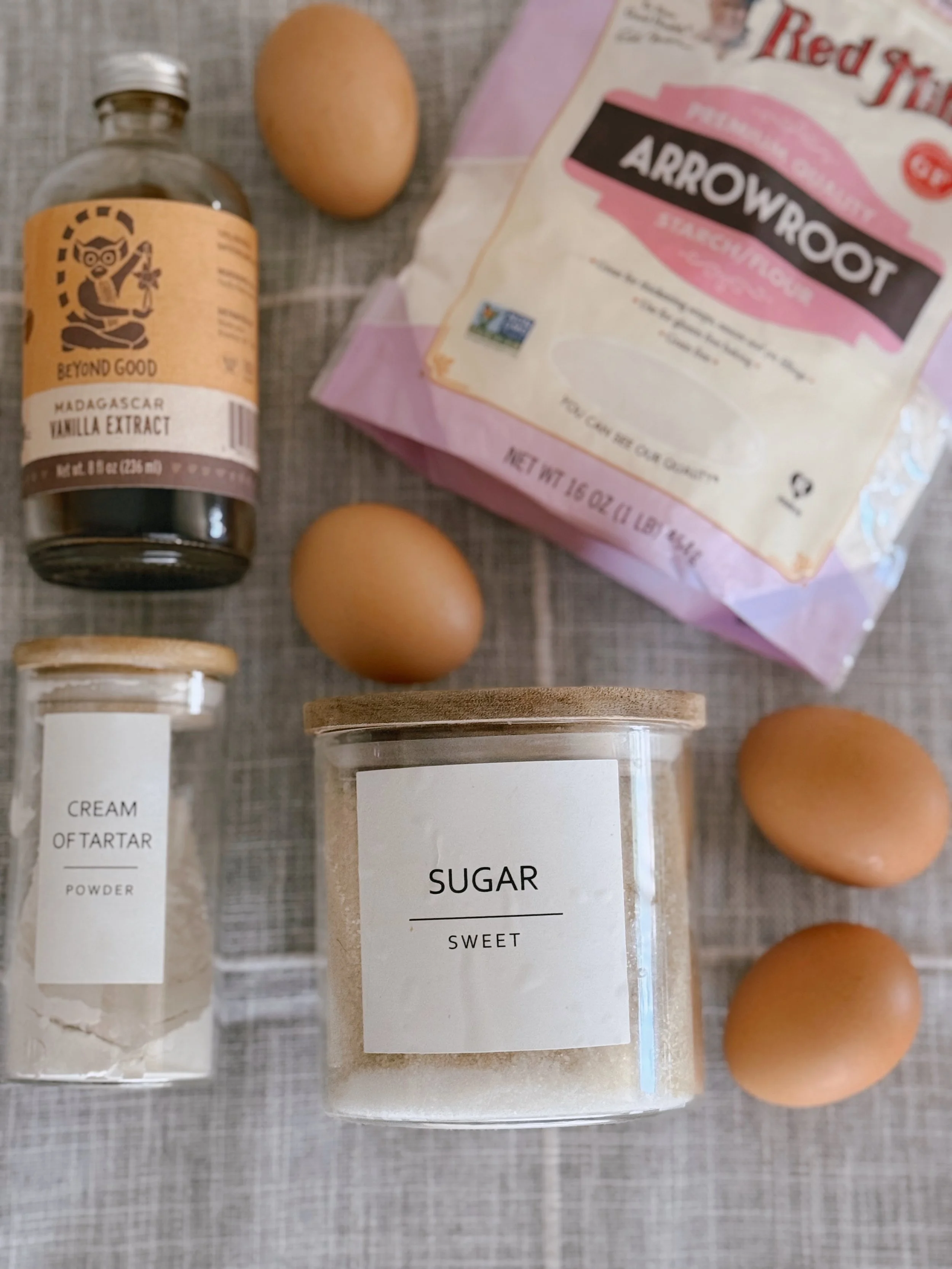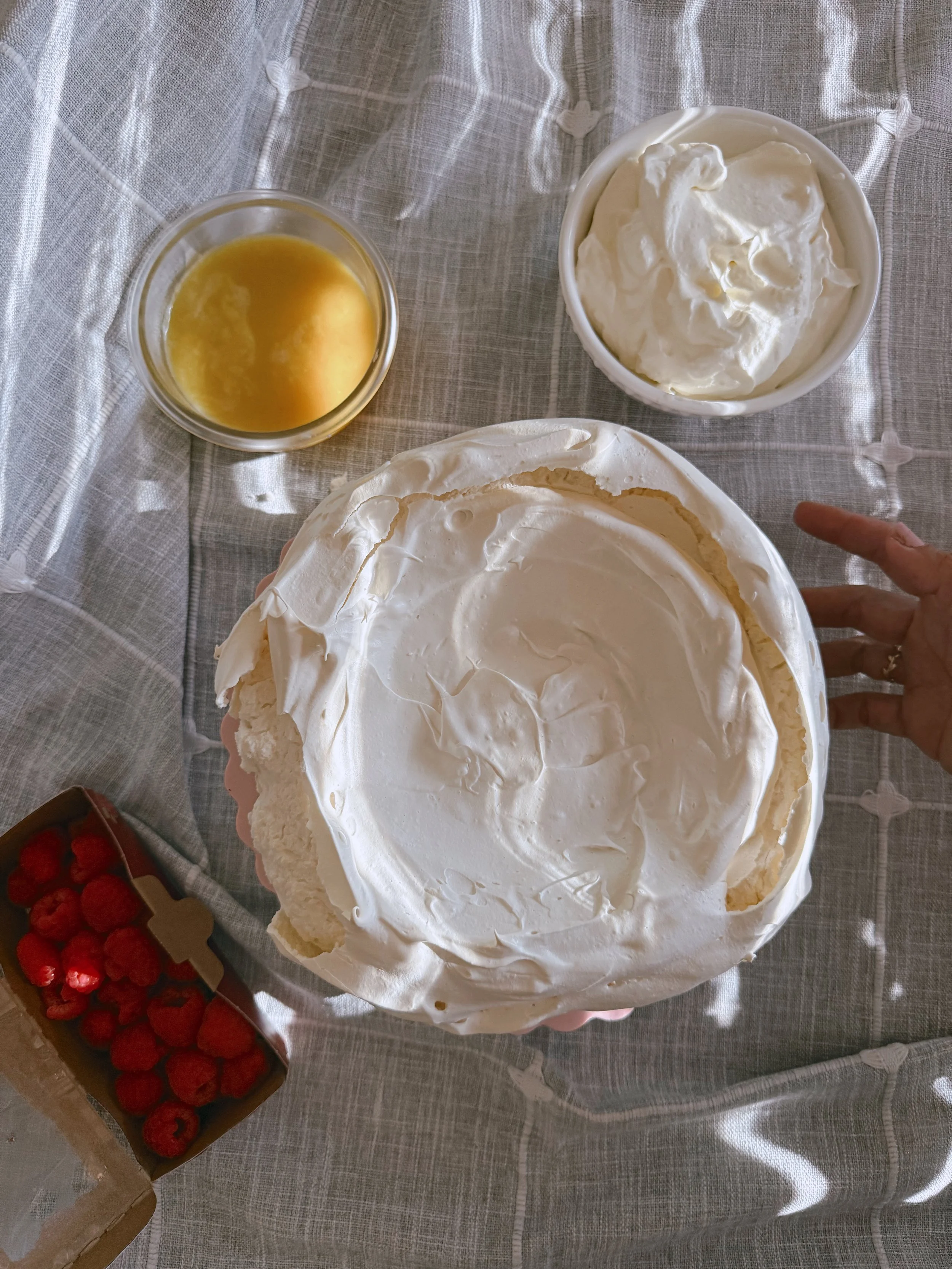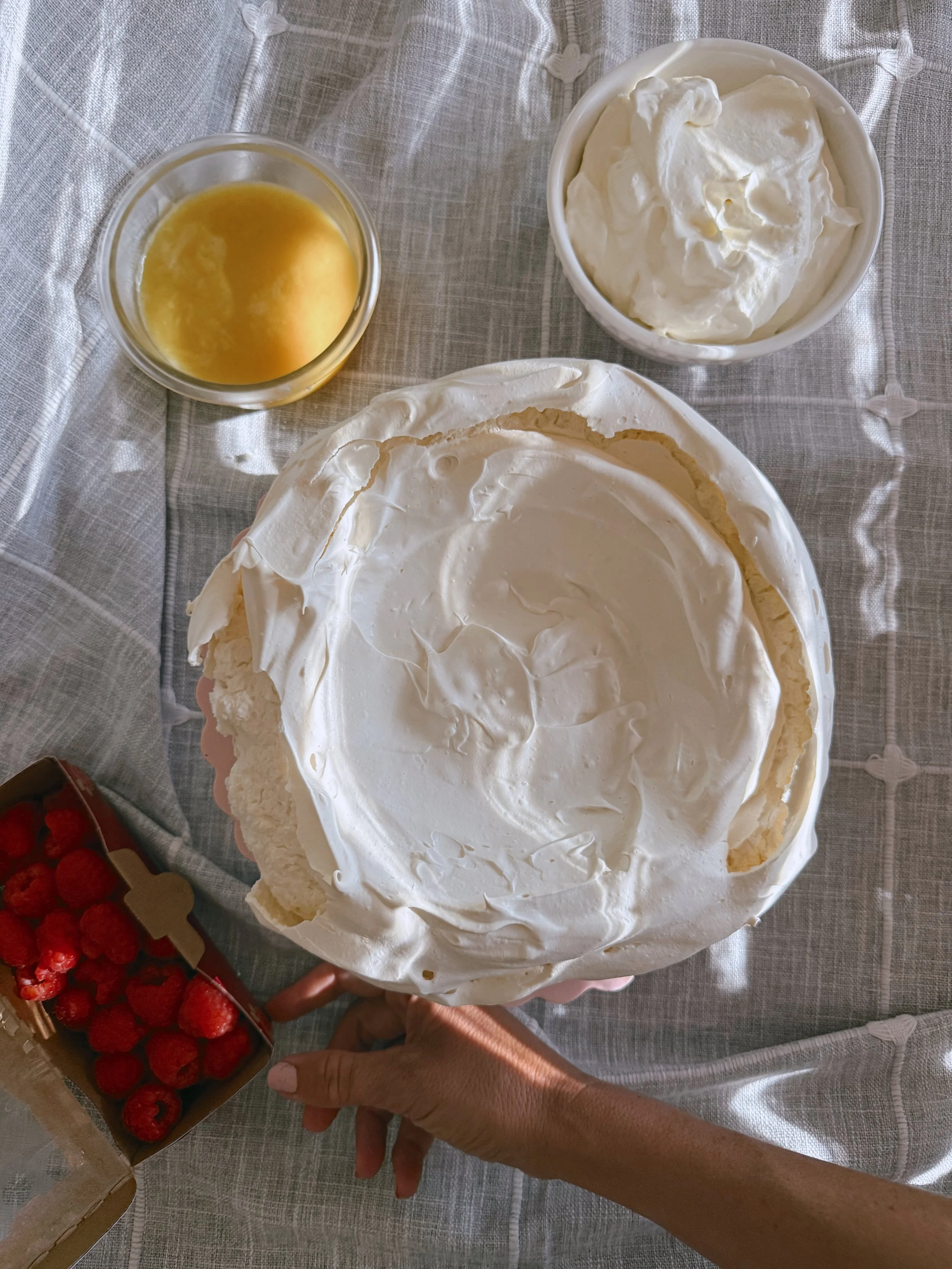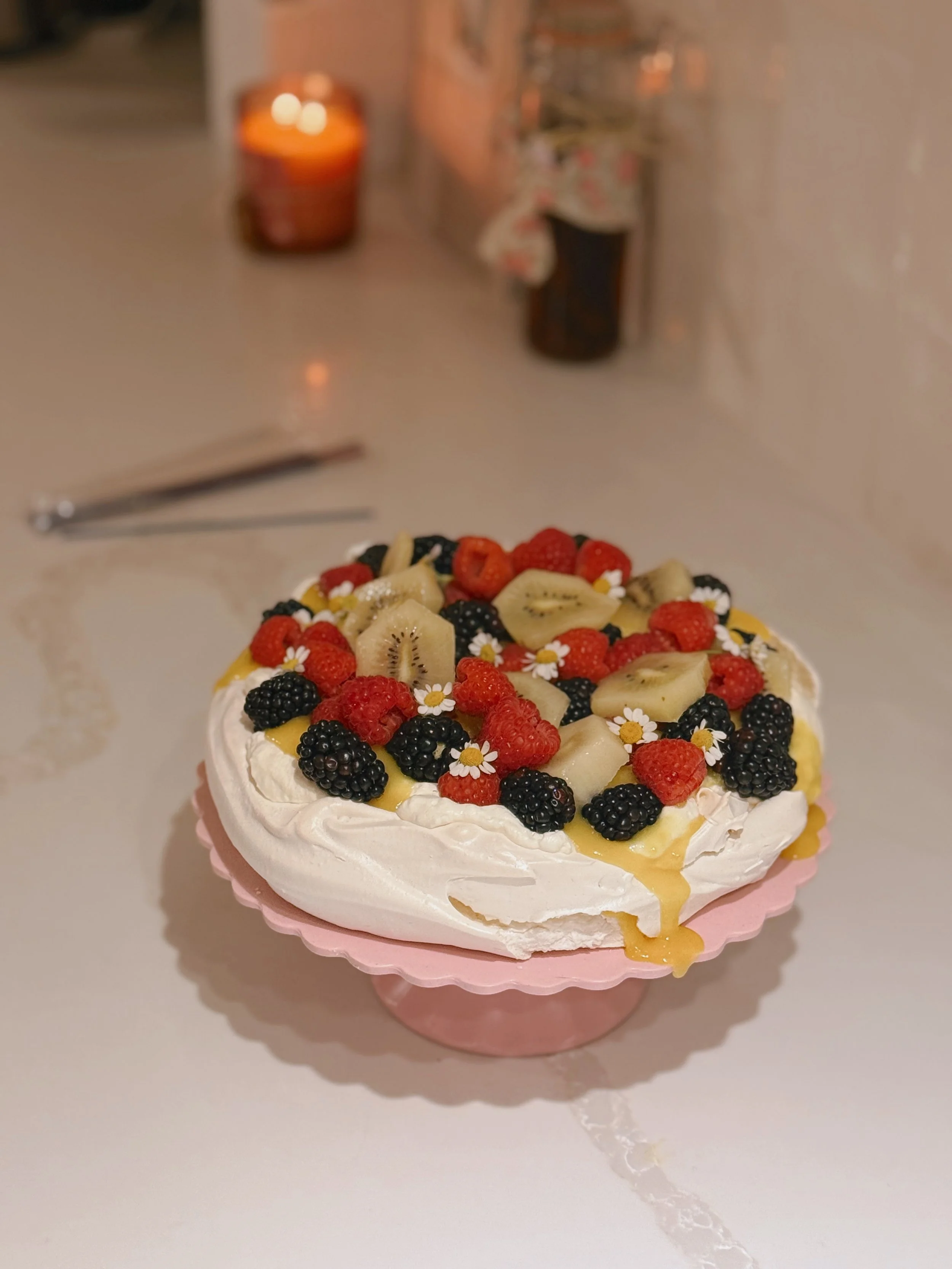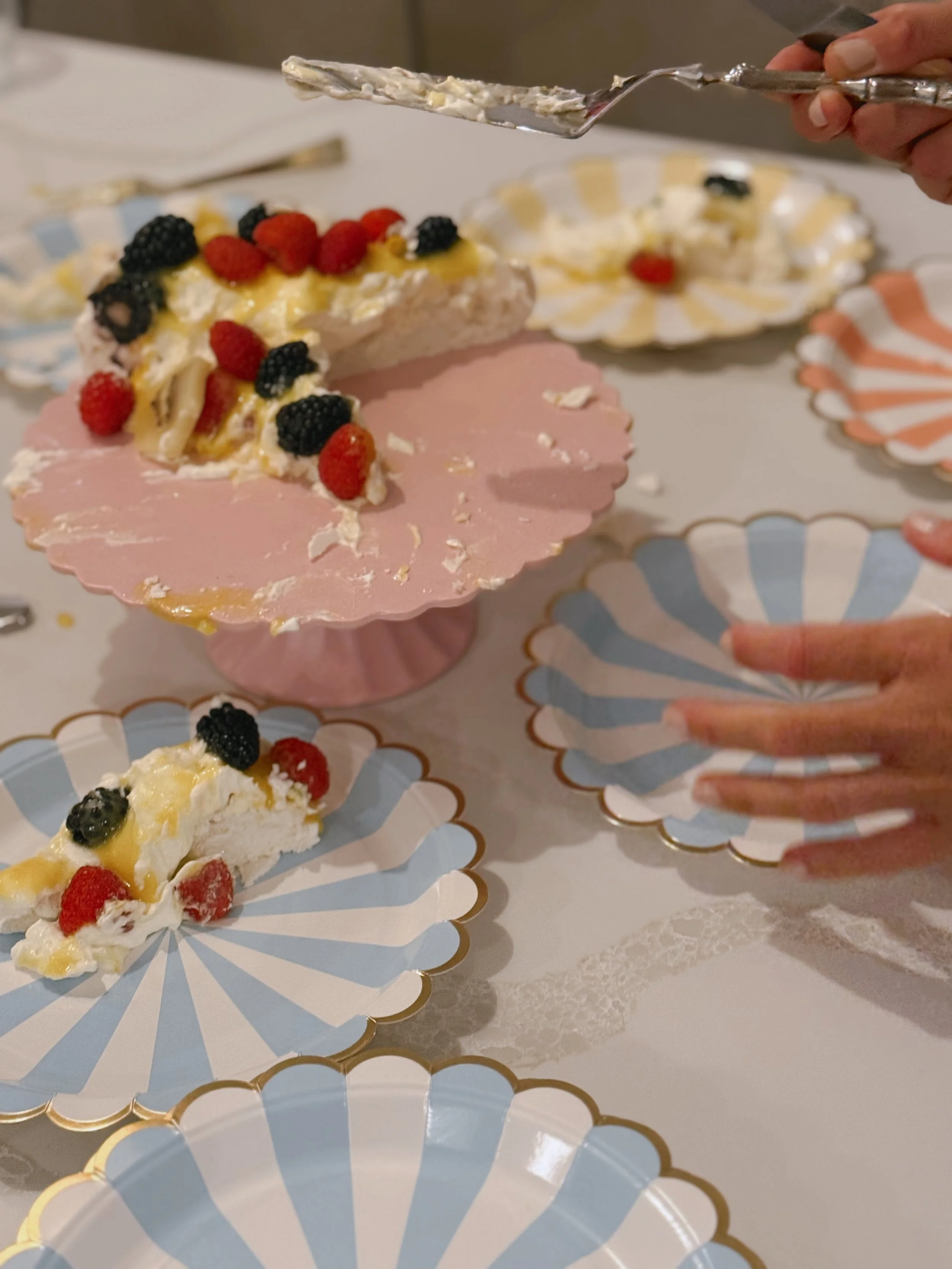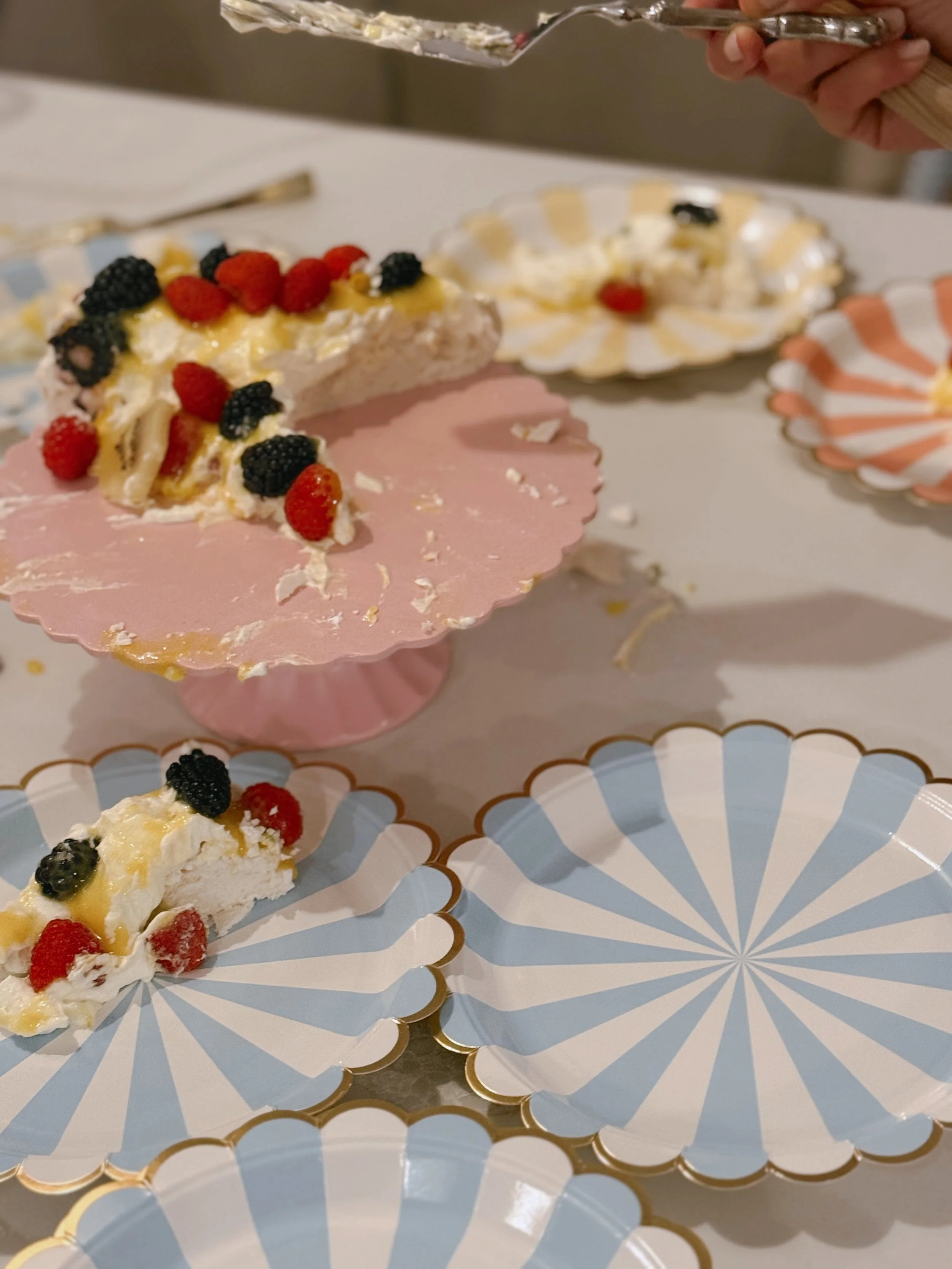Making a Perfect Pavlova (GF)
By: Courtney G. Clifford
There are desserts you enjoy, and then there are desserts you celebrate. Pavlova is firmly in the latter category. It’s a showstopper at dinner parties, birthdays, or even quiet nights when you just want something that feels extra special. Light yet indulgent, it’s one of those rare desserts that manages to be both elegant and playful at the same time. While the baking time is on the slower side, the overall recipe is fairly simple and has only 5 main ingredients, which I love for two reasons. I gravitate towards simplcity with ingredients and we almost always have the ingredients on hand, so making spontaneous pavlovas is a breeze.
Part of what makes pavlova so irresistible is its texture; every bite is a symphony of contrasts. The outside is crisp and delicate, almost like a thin sugared shell. Break into it, and you’re rewarded with a soft, marshmallowy interior that practically melts on your tongue. Add a swirl of cream, a spoonful of tart curd, and a scattering of fresh fruit, and you’ve got a dessert that feels like a cloud floating down to your plate.
And here’s a bonus: pavlova is naturally gluten-free, making it a crowd-pleaser for nearly any gathering.
Get ready for a pillowy crunchy chewy almost marshmallowy experience :)
A Dessert with a Story: The Origins of Pavlova
Like many beloved dishes, pavlova’s origin comes with a touch of controversy. Named after the world-famous Russian ballerina Anna Pavlova, who toured Australia and New Zealand in the 1920s, the dessert was created in her honor. Her dancing was described as light, airy, and ethereal—just like the sweet confection that now bears her name.
But who actually invented it? That depends on which side of the Tasman Sea you ask.
New Zealand claims pavlova was first whipped up by a Wellington hotel chef in 1926, inspired by Pavlova’s tutu.
Australia counters that it appeared around the same time in Perth, created by a hotel cook.
Wherever the truth lies, both countries have since embraced pavlova as a national treasure, serving it on holidays, birthdays, and festive occasions. Today, it’s loved worldwide as a dessert that feels luxurious but is surprisingly simple to make.
Why Pavlova is the Perfect Celebration Dessert
Pavlova isn’t just delicious—it’s endlessly customizable. Once you’ve nailed the meringue base, the rest is a blank canvas for your creativity.
You can:
Make one large, dramatic pavlova for a centerpiece.
Whip up mini individual pavlovas for dinner parties (they look stunning plated).
Stack layers high with cream and fruit for a cake-like tower.
Flavor-wise, there are no rules. Classic whipped cream and berries are always a hit, but pavlova also pairs beautifully with tropical fruits, citrus curds, chocolate, and even tea-infused creams.
Personally, I love using the leftover egg yolks to whip up a tangy lemon or mango curd, which I spread generously into the pavlova’s soft center. Paired with fresh berries and a dollop of whipped cream, it’s heaven on a plate. On other occasions, I’ve gone with matcha cream for a subtle earthy balance, or passion fruit pulp for a bold tropical punch. Shaved dark chocolate is another decadent touch that keeps guests coming back for seconds.
Recipe: Classic Pavlova
This recipe serves as the perfect base—crispy on the outside, marshmallowy inside, and ready for any topping you dream up.
Ingredients
4 large egg whites (room temperature)
1 cup superfine sugar
1 teaspoon vanilla extract
1 teaspoon arrowroot starch (cornstarch works in a pinch)
½ teaspoon cream of tartar
Instructions
Preheat & Prep
Preheat oven to 350°F (175°C). Line a baking sheet with parchment paper.Beat the Egg Whites
In a stand mixer with the whisk attachment (or using a hand mixer), beat egg whites on medium-high speed for about 5 minutes, until soft peaks form.Add Sugar Gradually
With the mixer running, add sugar in two parts, beating for 30 seconds between each addition. Once all sugar is added, turn speed to high and beat for 2 minutes, until glossy peaks form.Incorporate Flavor & Stabilizers
Add vanilla extract and beat 1 more minute, or until stiff peaks hold. Use a rubber spatula to gently fold in arrowroot starch and cream of tartar.Shape the Pavlova
Spread mixture into an 8–9 inch circle on your baking sheet. Create a slight dip in the center (this will hold your toppings later).Bake
Place pavlova in the oven, then immediately reduce temperature to 200°F (95°C). Bake for about 90 minutes, or until firm and dry to the touch. Avoid opening the oven door—sudden changes in temperature can cause cracks.Cool
Turn off oven and allow pavlova to cool completely inside. This prevents it from collapsing.Serve
Once cooled, top with your choice of cream, fruit, curd, or other creative additions. Pavlova is best enjoyed the same day but can be stored at room temperature for up to 2 days.Topping Inspiration
Classic Elegance: Fresh berries + whipped cream
Tropical Bliss: Mango curd + passion fruit pulp + coconut shavings
Tea-Time Twist: Matcha whipped cream + raspberries + dark chocolate curls
Citrus Sunshine: Lemon curd + blueberries + candied citrus peel
Decadent Delight: Whipped cream + espresso powder + shaved dark chocolate
Tips for Success
Room temperature eggs whip better (don’t skip this step).
Superfine sugar dissolves more evenly than regular sugar, creating a smooth meringue (simply pulse cane sugar in food processor or blender for about 30 seconds until the grain is fine).
No peeking! Or at least minimal. Resist the urge to open the oven while baking or cooling.
Humidity is the enemy- try to bake pavlova on a dry day, as moisture in the air can make it sticky.
Leftover yolks? Turn them into a luscious curd or homemade custard so nothing goes to waste.
A Dessert That Dances
It’s no wonder pavlova was named after a ballerina. Every forkful is light, delicate, and full of movement—crispy, chewy, and creamy all at once. Whether you’re serving it for a holiday, a birthday, or just a Saturday night treat, pavlova has a way of making the moment feel special.
It’s not just dessert; it’s a celebration in itself.
References:
Bake from Scratch. (2019, April 2). Origin of the classic pavlova. Bake from Scratch. https://bakefromscratch.com/origin-classic-pavlova
Encyclopaedia Britannica. (n.d.). Pavlova dessert. In Britannica. Retrieved August 25, 2025, from https://www.britannica.com/topic/pavlova
Food52. (2016, August 16). The dessert Australians and New Zealanders are squabbling over. Food52. https://food52.com/story/16810-the-dessert-australians-and-new-zealanders-are-squabbling-over
National Geographic. (2020, December 24). The story behind pavlova: Where to eat it, and how to make it. National Geographic. https://www.nationalgeographic.com/travel/article/the-story-behind-pavlova-recipe-where-to-eat
The Guardian. (2019, August 21). How to cook the perfect pavlova. The Guardian. https://www.theguardian.com/food/2019/aug/21/how-to-cook-the-perfect-pavlova-recipe
Wikipedia contributors. (2025, August 25). Pavlova (food). In Wikipedia. https://en.wikipedia.org/wiki/Pavlova
